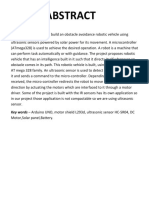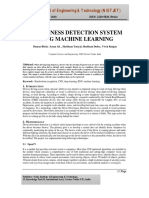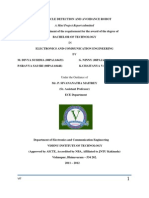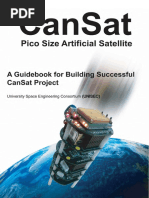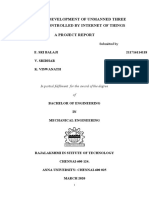0 ratings0% found this document useful (0 votes)
267 viewsObstacle Avoiding Robot 1920
This document summarizes a project seminar on an obstacle avoiding robot created by three students under the guidance of their professor. It includes sections on the introduction, literature review, design and hardware requirements, block diagram, working principle, applications, future scope, and conclusion. The obstacle avoiding robot uses an ultrasonic sensor and Arduino to detect and navigate around obstacles on its path.
Uploaded by
Abhishek ViraleCopyright
© © All Rights Reserved
Available Formats
Download as PPTX, PDF, TXT or read online on Scribd
0 ratings0% found this document useful (0 votes)
267 viewsObstacle Avoiding Robot 1920
This document summarizes a project seminar on an obstacle avoiding robot created by three students under the guidance of their professor. It includes sections on the introduction, literature review, design and hardware requirements, block diagram, working principle, applications, future scope, and conclusion. The obstacle avoiding robot uses an ultrasonic sensor and Arduino to detect and navigate around obstacles on its path.
Uploaded by
Abhishek ViraleCopyright
© © All Rights Reserved
Available Formats
Download as PPTX, PDF, TXT or read online on Scribd
You are on page 1/ 13
A Project Seminar on
OBSTACLE AVOIDING ROBOT
Prepared by
SHUBHAM SATTARWAR
HRISHIKESH IPALPALLI
ABHISHEK VIRALE
Under the Guidance of
Prof. A.I. REHMAN
Department of Mechanical Engineering
M.G.M’s College Of Engineering
Nanded-431605
2019-2020
CONTENTS
• INTRODUCTION
• LITERATURE REVIEW
• DESIGN AND HARDWARE REQUIREMENTS
• BLOCK DIAGRAM
• WORKING PRINCIPLE
• APPLICATIONS
• FUTURE SCOPE
• CONCLUSION
• REFERENCES
INTRODUCTION
• Robotics is part of today's communication. In today’s world ROBOTICS
is fast growing and interesting field. It is simplest way for latest
technology modification. Now a days communication is part of
advancement of technology, so we decided to work on robotics field,
and design something which will make human life simpler in day today
aspect. Thus we are supporting this cause.
• An obstacle avoiding robot is an intelligent device, which can
automatically sense and overcome obstacles on its path. Obstacle
Avoidance is a robotic discipline with the objective of moving vehicles
on the basis of the sensorial information. The use of these methods front
to classic methods (path planning) is a natural alternative when the
scenario is dynamic with an unpredictable behavior. In these cases, the
surroundings do not remain invariable, and thus the sensory information
is used to detect the changes consequently adapting moving. It will
automatically scan the surrounding for further path.
LITERATURE REVIEW
We reviewed different obstacle detecting robot mechanisms that have
been built by a lot of students and other practitioners that are in
existence. For an autonomous mobile robot performing a navigation-
based task in a vague environment, to detect and to avoid encountered
obstacles is an important issue and a key function for the robot body safety
as well as for the task continuity. Obstacle detection and avoidance in a
real world environment that appears so easy to humans is a rather
difficult task for autonomous mobile robots and is still a well- researched
topic in robotics. In many previous works, a wide range of sensors and
various methods for detecting and avoiding obstacles for mobile robot
purpose have been proposed. Good references related to the developed
sensor systems and proposed detection and avoidance algorithms can be
found. Based on these developed sensor systems, various approaches
related to this work can be grouped.
DESIGN AND HARDWARE
REQUIREMENTS
DESIGN:
HARDWARE:
• Arduino uno
• Ultrasonic sensor
• Motor (100 RPM)
• Motor driver IC (L293D)
• Breadboard
BLOCK DIAGRAM
The block diagram shown above mainly consists of the following
essential blocks:
• Arduino uno
• Ultrasonic sensor
• Motor driver (L293D)
WORKING PRINCIPLE
The obstacle avoidance robotic vehicle uses ultrasonic
sensors for its movements. Arduino is used to achieve the
desired operation. The motors are connected through motor
driver IC to Arduino. The ultrasonic sensor is attached in
front of the robot.
Whenever the robot is going on the desired path the
ultrasonic sensor transmits the ultrasonic waves continuously
from its sensor head. Whenever an obstacle comes
ahead of it the ultrasonic waves are reflected back from
an object and that information is passed to the
arduino. The arduino controls the motors left, right, back,
front, based on ultrasonic signals. In order to control
the speed of each motor pulse width modulation is used (PWM).
When ultrasonic sensor detect the object which is kept inside the path
it will send the signal toward the arduino uno and according to that it
will it will rotate the motor M3 & M4 in forward direction and rotate the
motor M1 & M2 in reverse direction such way that the car get moving in
left direction .
APPLICATIONS
• Automated lawn mower.
• Smart room cleaner.
• In mines.
• With proper programming we can use it as a weight lifter, auto
parking assistance.
• Roaming aid for blind people.
FUTURE SCOPES
• Using as a firefighting robot.
• Adding a camera and using for survey purpose.
• Using as a supply vehicle in disaster situations.
CONCLUSION
The goal of our project is to create an autonomous robot which
intelligently detects the obstacle in its path and navigate according
to the actions we set for it.
REFERENCES
Books:
• D. Floreano and J. Urzelai. “Evolutionary Robots with Online Self-
Organization and Behavioral Fitness”
• Oussama Khatib. “Real-Time Obstacle Avoidance for
Manipulators and Mobile Robots”
• Marija Seder. “Hierarchical Path Planning of Mobile robots in
Complex Indoor Environments ”
Magazines:
• Electronics for you
• Electronic Hub
You might also like
- Key Words - Arduino UNO, Motor Shield L293d, Ultrasonic Sensor HC-SR04, DCNo ratings yetKey Words - Arduino UNO, Motor Shield L293d, Ultrasonic Sensor HC-SR04, DC17 pages
- Arduino Based Surveillance Robot: Bachelor of Science (Information Technology)No ratings yetArduino Based Surveillance Robot: Bachelor of Science (Information Technology)26 pages
- Design and Analysis of IoT-Based Intelligent Robot For Real-Time Monitoring and ControlNo ratings yetDesign and Analysis of IoT-Based Intelligent Robot For Real-Time Monitoring and Control13 pages
- Detection of Potholes, Humps and Measuring Distance Between Two Vehicles Using Ultrasonic Sensor and AccelerometerNo ratings yetDetection of Potholes, Humps and Measuring Distance Between Two Vehicles Using Ultrasonic Sensor and Accelerometer6 pages
- A Review of Deep Learning Methods and Applications For PDFNo ratings yetA Review of Deep Learning Methods and Applications For PDF14 pages
- Providing Security To The Vehicle Ignition System UsingFingerprint Technology and Driving LicenseNo ratings yetProviding Security To The Vehicle Ignition System UsingFingerprint Technology and Driving License9 pages
- Study and Implementation of Object Detection and Visual TrackingNo ratings yetStudy and Implementation of Object Detection and Visual Tracking32 pages
- Dr. Rajendra Gode Institute of Technology & Research: "Automatic Pothole Detection While Driving"No ratings yetDr. Rajendra Gode Institute of Technology & Research: "Automatic Pothole Detection While Driving"20 pages
- RF Based Smart Zone Vehicle Speed Monitoring and Control SystemNo ratings yetRF Based Smart Zone Vehicle Speed Monitoring and Control System2 pages
- Project Report On Global Positioning System GPSNo ratings yetProject Report On Global Positioning System GPS38 pages
- 4 Degree of Freedom Robotic Arm Using Arduino Nano (Microcontroller)No ratings yet4 Degree of Freedom Robotic Arm Using Arduino Nano (Microcontroller)16 pages
- (Ultrasonic Radar-Naman Kataria-CSB) PresentationNo ratings yet(Ultrasonic Radar-Naman Kataria-CSB) Presentation15 pages
- Drowsiness Detection System Using Machine LearningNo ratings yetDrowsiness Detection System Using Machine Learning4 pages
- Android Application For Structural Health Monitoring and Data Analytics of Roads PDFNo ratings yetAndroid Application For Structural Health Monitoring and Data Analytics of Roads PDF5 pages
- IOT Project Report: Solar Panel Monitoring SystemNo ratings yetIOT Project Report: Solar Panel Monitoring System13 pages
- IOT Based Air Quality Monitoring and LPG Gas Leakage Detection SystemNo ratings yetIOT Based Air Quality Monitoring and LPG Gas Leakage Detection System29 pages
- Wifi Controlled Obstacle Avoiding Robotics CarNo ratings yetWifi Controlled Obstacle Avoiding Robotics Car13 pages
- MINOR BTP Report - Arduino Based Vehicle Accident Alert System Using GPS, GSM and AccelerometerNo ratings yetMINOR BTP Report - Arduino Based Vehicle Accident Alert System Using GPS, GSM and Accelerometer40 pages
- Omni Wheels Robot For Effective Surveillance and Transportation PurposeNo ratings yetOmni Wheels Robot For Effective Surveillance and Transportation Purpose8 pages
- Visually Impaired People Monitoring in A Smart Home Using Electronic White CaneNo ratings yetVisually Impaired People Monitoring in A Smart Home Using Electronic White Cane10 pages
- Index: Savitribai Phule Pune University, PuneNo ratings yetIndex: Savitribai Phule Pune University, Pune10 pages
- IoT Based Intelligent Traffic Management SystemNo ratings yetIoT Based Intelligent Traffic Management System3 pages
- Guide Name Presented By: Mr. Mukul Kumar Singh Amit Yadav (13EE08)No ratings yetGuide Name Presented By: Mr. Mukul Kumar Singh Amit Yadav (13EE08)19 pages
- Design and Implementation of An Intelligent Animal Intrusion Detection SystemNo ratings yetDesign and Implementation of An Intelligent Animal Intrusion Detection System17 pages
- Intelligent Walking Stick For Elderly and Blind People IJERTV9IS030043No ratings yetIntelligent Walking Stick For Elderly and Blind People IJERTV9IS0300434 pages
- Smart Crop Protection System From Animals PICNo ratings yetSmart Crop Protection System From Animals PIC7 pages
- Vision Based Lane Detection For Unmanned Ground Vehicle (UGV)No ratings yetVision Based Lane Detection For Unmanned Ground Vehicle (UGV)19 pages
- Real Time Hand Gesture Recognition Based Control of Arduino RobotNo ratings yetReal Time Hand Gesture Recognition Based Control of Arduino Robot5 pages
- Design and Development of Unmanned Three Wheeler Controlled by Internet of Things A Project ReportNo ratings yetDesign and Development of Unmanned Three Wheeler Controlled by Internet of Things A Project Report60 pages
- PDF - Next Step Home Automatio Final Paper 150919No ratings yetPDF - Next Step Home Automatio Final Paper 1509196 pages
- An Introduction to 3D Computer Vision Techniques and AlgorithmsFrom EverandAn Introduction to 3D Computer Vision Techniques and AlgorithmsNo ratings yet
- The Today and Future of WSN, AI, and IoT: A Compass and Torchbearer for the TechnocratsFrom EverandThe Today and Future of WSN, AI, and IoT: A Compass and Torchbearer for the TechnocratsNo ratings yet
- En Koodave Irum O Yesuve - Tamil Christian Song Keyboard Notation Notes PDF-Kve MusicNo ratings yetEn Koodave Irum O Yesuve - Tamil Christian Song Keyboard Notation Notes PDF-Kve Music1 page
- Analysis of Synchronous Generator Internal Insulation Failures100% (2)Analysis of Synchronous Generator Internal Insulation Failures5 pages
- Mina Petrila-Spatiu Exterior 2 - 14 03 2024-ModelNo ratings yetMina Petrila-Spatiu Exterior 2 - 14 03 2024-Model1 page
- MODELS 373LAV, 376CAV Downflow/Horizontal and 383kav, 395cav Upflow Gas Furnace50% (2)MODELS 373LAV, 376CAV Downflow/Horizontal and 383kav, 395cav Upflow Gas Furnace12 pages
- PM Reyes Notes On Taxation 2 - Valued Added Tax (Working Draft)100% (1)PM Reyes Notes On Taxation 2 - Valued Added Tax (Working Draft)22 pages
- Polisomnografí A Dinamica No Dise.: Club de Revistas Julián David Cáceres O. OtorrinolaringologíaNo ratings yetPolisomnografí A Dinamica No Dise.: Club de Revistas Julián David Cáceres O. Otorrinolaringología25 pages
- Promotional Strategies & Print Ad For Cold Creams100% (1)Promotional Strategies & Print Ad For Cold Creams12 pages
- Swarm Robotics: Fundamentals and ApplicationsFrom EverandSwarm Robotics: Fundamentals and Applications
- Key Words - Arduino UNO, Motor Shield L293d, Ultrasonic Sensor HC-SR04, DCKey Words - Arduino UNO, Motor Shield L293d, Ultrasonic Sensor HC-SR04, DC
- Arduino Based Surveillance Robot: Bachelor of Science (Information Technology)Arduino Based Surveillance Robot: Bachelor of Science (Information Technology)
- Design and Analysis of IoT-Based Intelligent Robot For Real-Time Monitoring and ControlDesign and Analysis of IoT-Based Intelligent Robot For Real-Time Monitoring and Control
- Detection of Potholes, Humps and Measuring Distance Between Two Vehicles Using Ultrasonic Sensor and AccelerometerDetection of Potholes, Humps and Measuring Distance Between Two Vehicles Using Ultrasonic Sensor and Accelerometer
- A Review of Deep Learning Methods and Applications For PDFA Review of Deep Learning Methods and Applications For PDF
- Providing Security To The Vehicle Ignition System UsingFingerprint Technology and Driving LicenseProviding Security To The Vehicle Ignition System UsingFingerprint Technology and Driving License
- Study and Implementation of Object Detection and Visual TrackingStudy and Implementation of Object Detection and Visual Tracking
- Dr. Rajendra Gode Institute of Technology & Research: "Automatic Pothole Detection While Driving"Dr. Rajendra Gode Institute of Technology & Research: "Automatic Pothole Detection While Driving"
- RF Based Smart Zone Vehicle Speed Monitoring and Control SystemRF Based Smart Zone Vehicle Speed Monitoring and Control System
- 4 Degree of Freedom Robotic Arm Using Arduino Nano (Microcontroller)4 Degree of Freedom Robotic Arm Using Arduino Nano (Microcontroller)
- Drowsiness Detection System Using Machine LearningDrowsiness Detection System Using Machine Learning
- Android Application For Structural Health Monitoring and Data Analytics of Roads PDFAndroid Application For Structural Health Monitoring and Data Analytics of Roads PDF
- IOT Based Air Quality Monitoring and LPG Gas Leakage Detection SystemIOT Based Air Quality Monitoring and LPG Gas Leakage Detection System
- MINOR BTP Report - Arduino Based Vehicle Accident Alert System Using GPS, GSM and AccelerometerMINOR BTP Report - Arduino Based Vehicle Accident Alert System Using GPS, GSM and Accelerometer
- Omni Wheels Robot For Effective Surveillance and Transportation PurposeOmni Wheels Robot For Effective Surveillance and Transportation Purpose
- Visually Impaired People Monitoring in A Smart Home Using Electronic White CaneVisually Impaired People Monitoring in A Smart Home Using Electronic White Cane
- Guide Name Presented By: Mr. Mukul Kumar Singh Amit Yadav (13EE08)Guide Name Presented By: Mr. Mukul Kumar Singh Amit Yadav (13EE08)
- Design and Implementation of An Intelligent Animal Intrusion Detection SystemDesign and Implementation of An Intelligent Animal Intrusion Detection System
- Intelligent Walking Stick For Elderly and Blind People IJERTV9IS030043Intelligent Walking Stick For Elderly and Blind People IJERTV9IS030043
- Vision Based Lane Detection For Unmanned Ground Vehicle (UGV)Vision Based Lane Detection For Unmanned Ground Vehicle (UGV)
- Real Time Hand Gesture Recognition Based Control of Arduino RobotReal Time Hand Gesture Recognition Based Control of Arduino Robot
- Design and Development of Unmanned Three Wheeler Controlled by Internet of Things A Project ReportDesign and Development of Unmanned Three Wheeler Controlled by Internet of Things A Project Report
- An Introduction to 3D Computer Vision Techniques and AlgorithmsFrom EverandAn Introduction to 3D Computer Vision Techniques and Algorithms
- The Today and Future of WSN, AI, and IoT: A Compass and Torchbearer for the TechnocratsFrom EverandThe Today and Future of WSN, AI, and IoT: A Compass and Torchbearer for the Technocrats
- En Koodave Irum O Yesuve - Tamil Christian Song Keyboard Notation Notes PDF-Kve MusicEn Koodave Irum O Yesuve - Tamil Christian Song Keyboard Notation Notes PDF-Kve Music
- Analysis of Synchronous Generator Internal Insulation FailuresAnalysis of Synchronous Generator Internal Insulation Failures
- MODELS 373LAV, 376CAV Downflow/Horizontal and 383kav, 395cav Upflow Gas FurnaceMODELS 373LAV, 376CAV Downflow/Horizontal and 383kav, 395cav Upflow Gas Furnace
- PM Reyes Notes On Taxation 2 - Valued Added Tax (Working Draft)PM Reyes Notes On Taxation 2 - Valued Added Tax (Working Draft)
- Polisomnografí A Dinamica No Dise.: Club de Revistas Julián David Cáceres O. OtorrinolaringologíaPolisomnografí A Dinamica No Dise.: Club de Revistas Julián David Cáceres O. Otorrinolaringología


